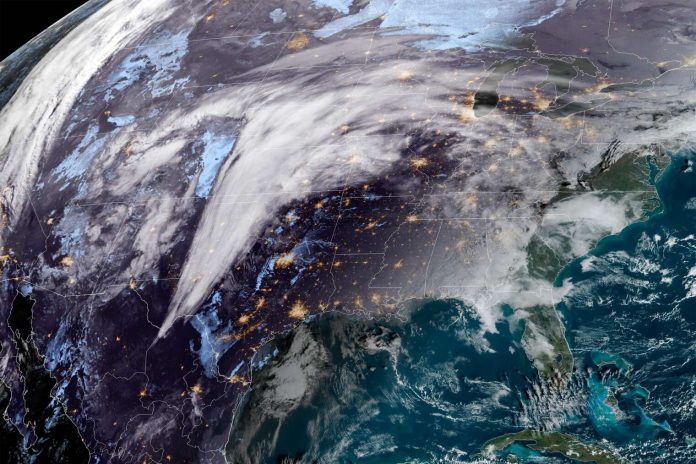|
Lazy eyes listen
|
NewsRescue
Officials have warned that a winter storm moving across the central Plains and Upper Midwest this week will bring heavy snow, sleet, and freezing rain to parts of the United States, while tornadoes may form further south.
According to the National Weather Service, the storm will bring snow to the Central High Plains as it moves northeast into the Great Lakes, producing moderate to heavy snow, sleet, and freezing rain by Tuesday.
“Intense snow rates of 1-2 inches per hour may be accompanied by thunder, particularly in southern South Dakota and far southwest Minnesota,” the National Weather Service warned in an early Monday forecast update. More than 12 inches of heavy snow is expected to fall quickly from the Nebraska Panhandle to southwest Minnesota, according to the forecast.
Strong winds are also expected to create areas of blowing and drifting snow, which the weather service warns could result in snow-covered roads and reduced visibility, posing potential travel hazards.
On January 2, 2023, a satellite view of the weather system currently over the United States.
According to the National Weather Service, the weather system is also expected to bring significant freezing rain to parts of northeastern Nebraska and southern Minnesota. It warned that the freezing rain could complicate travel and cause power outages.
According to the weather service, moisture from the Western Gulf of Mexico is expected to move northward over the Western Gulf Coast/Lower Mississippi Valley, with the Plains front moving into the moisture, resulting in showers and severe thunderstorms over the area on Monday morning. From Monday morning to Tuesday morning, the Lower Mississippi Valley is under a high risk of severe thunderstorms.
The thunderstorms are expected to bring frequent lightning, severe thunderstorm wind gusts, hail, and “a few tornadoes,” according to the National Weather Service.
Heavy rain is also expected as a result of the thunderstorms, with the National Weather Service issuing a slight risk of excessive rainfall over parts of the Middle/Lower Mississippi Valley on Monday and Tuesday.
“The associated heavy rain will produce primarily localized flash flooding, with urban areas, roads, and small streams being the most vulnerable,” the weather service predicted.
Severe thunderstorms are possible in parts of east Texas, southeastern Oklahoma, Arkansas, and northern Louisiana on Monday afternoon and evening.
Nearly 19 million people are in the path of storms that could bring tornadoes, damaging wind gusts, flooding, and hail.
Flood Warnings continue in Arkansas, western Tennessee, northern Louisiana, and east Texas through Monday night.
Severe storms are expected to continue eastward on Tuesday, affecting areas across the Tennessee Valley and the central Gulf Coast.
It comes after a “once-in-a-lifetime” blizzard killed dozens last month, with Erie County, New York, including Buffalo, at the epicenter of the storm’s most severe conditions.
On MSNBC’s “Morning Joe,” Buffalo Mayor Byron Brown said the storm was “probably worse than anything this city has seen in over 50 years.”





